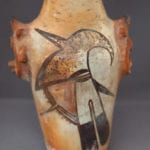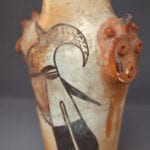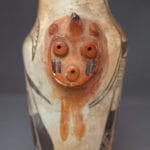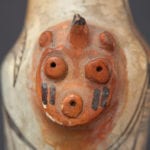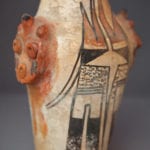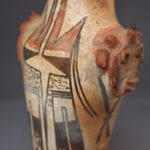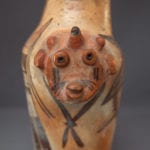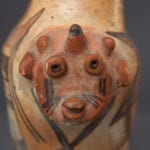Two applied Koyemsi heads grace this otherwise fairly ordinary Nampeyo vase.
Decorating pots with raised decoration is unusual but not unknown at Hopi.
The two painted designs on this vase are well below Nampeyo’s standards and create some uncertainty about the jar’s origin.
This is an experimental pot:
Throughout her career, Nampeyo was curious and innovative. Vase 2017-01 is one product of that temperament. During the late 19th century Nampeyo drew inspiration for designs from a variety of sources other than Sikyatki, including Kayenta black-on-cream ware (2012-02), Acoma pueblo (2015-03) and Hopi petroglyphs (2009-08). During the first few years of the 20th century Nampeyo continued to experiment with a variety of unusual designs and forms.
“During (this period, 1900-1910) the proficient, prolific potter (Nampeyo) improvised continually and produced more diversified work than in any other period (Kramer, 1996:168).”
She painted abstract designs that had little precedent in ancient pueblo pottery and foretold the European cubist movement a decade later (2006-11 and 2015-04). Vessels of unusual form by her from this period included a lobed seedjar (2015-12), and jars with figurative forms: human faces (2007-16 and 2013-14) and mountain sheep heads (2014-17). Because of its applied koyemsi faces, vase 2017-01 joins this list of exocentric, innovative vessels. During a phone conversation on March 28, 2017, Ed Wade suggested that Nampeyo’s interest in building a figure by the application of clay to the external surface of a pot was probably a technique that Nampeyo learned from Zuni, perhaps Zuni pottery she saw for sale at Hopi House, 1905 or 1907.
Iris Youvella (2003-08) and Gwen Setalla (2016-07) currently use appliqué corn to decorate their pottery. Al Qoyawayma (2006-03) uses repose to form figurative designs on his pottery, a technique he learned from his aunt Elizabeth White (Polingaysi, 2005-08). Daisy Hooee, Nampeyo’s granddaughter, drew on her diverse experience to create a unique jar with a Hopi body and appliqué Zuni frogs (2011-13). Nevertheless, other than work by these artists, Hopi jars with repose or applied figures are rare, perhaps unknown.
Form:
The shape of vase 2017-01 is more European than Hopi. The narrow 2.5” base tapers gently outward to the maximum width two thirds up the jar’s height, then a more sharply-angled inward taper ends at the mouth, which is about 2 inches wide. The overall shape is somewhat similar to Nampeyo’s vase 2013-03 in this collection, though that vase is more graceful, has thinner walls, and is more symmetrical than the Koyemsi vase discussed here.
The asymmetry of jar 2017-01 may be due to the difficulty of forming the pot around the clay for the Koyemsi heads. Up to the point where the jar reaches maximum diameter, it seems symmetrical and well formed. At this point the jar is about 4 inches wide, enough room for Nampeyo to reach in and brace the inner walls while she pressed the clay for the Koyemsi heads onto the exterior surface. The clay for the heads rises above this point, however, and the next coil of clay to build up the walls would have to have been fitted behind the external plaques of clay meant for the Koyemsi.
Hopi and Hopi/Tewa pots are built on a puki, generally a round bottomed base that can be turned as a potter works her way around the rim of a pot building up its walls. Experienced potters like Nampeyo work astonishingly fast adding coils and smoothing the clay to form almost perfectly round vessels. On jar 2017-01 I surmise that, on the unfinished vessel, the protruding tabs of clay for the Koyemsi heads interrupted Nampeyo’s usual rhythm and thus additional upper coils were added with an uneven list, resulting in the asymmetric top section of this vase.
There is some evidence that the form of a vessel sometimes interested Nampeyo less than other considerations. The Blairs noticed this pattern:
“Several of the pottery pieces attributed to Nampeyo…can best be described as poorly formed and polished but beautifully decorated (fig 2.24). One gets the impression that these forms were hurriedly made to allow the artist to move on quickly to the more interesting and pleasant task of painting her newly inspired designs…(They) illustrate what appears to be a period when Nampeyo emphasized painted design over pottery structure, although it is posible that they were formed by other family members. Both (illustrated) pieces are small and roughly formed with thick, non-uniform walls and obvious surface defects….Both were collected between October 1903 and February 1904 (1999:83).”
A third example of this disjuncture between form and design is part of this collection: see pot 2012-08, a clunky form carrying an elegant, carefully-painted design .
A similar dynamic may define vase 2017-01 as Nampeyo seems to have been primarily interested in fixing applied figures to a jar without too much regard for the overall form of the vessel or the painting of the two inelegant designs.
A chip at the rim reveals that the core of vase 2017-01 is built of clay that fired brick red. That’s odd; most Hopi pots are built with a core of grey clay. There is a raw yellow clay at Hopi (“sikyatska”) that turns red upon firing. This is generally used as a slip over a grey clay core, but sometimes (cf 2010-08) an entire vessel may be made of sikyatska clay. Vase 2017-01 is the only Hopi (Hopi/Tewa) pot I know of which has red clay used as a core that was then covered by a light slip. This slip was then stone polished using strokes parallel with the height of the vessel, a somewhat exacting technique resulting in an “onion skin” texture. The inside of vase 2017-01 is exceptionally dirty, as if someone had used it as a planter, a possibility reinforced by pitting in the slip about 1.5” above the base. Such pitting is characteristic of a Hopi vase having been used to hold water.
Design:
The vessel carries four design motifs: two applied faces representing koyemsi dancers and two painted designs. The two koyemsi faces are different from each other, as are the two painted panels.
Koyemsi in Hopi ritual:
Harold Colton established the accepted typology of Hopi kachinas. The image on jar 2017-01 is of a Koyemsi or mud head clown, Colton #59: (Colton, 1959: 34).
Reddish brown sack mask to which are fastened three gourds, one on top and one over each ear, and painted reddish brown…Koyemsi is the most common Hopi clown. He appears in Mixed Kachina Dances and sometimes a group of Koyemsi appears in a dance of their own.
Barton Wright (1994) wrote a book Clowns of the Hopi, which builds on Colton’s work and includes an extended discussion of Koyemsi. He writes that koyemsi are not kachinas, but are spirit beings and most often serve as interlocutors between kachinas and humans. They present themselves in at least two-dozen forms (1994: 68-69, 95-97). About the time jar 2017-01 was made, the Hopi had two varieties of Ball-on-Head beings. One native Hopi version was called Tachukti, the other a then recent import from Zuni. Alexander Stephen observed a dance including Tachukti at First Mesa in January 1893 (1936:169). Within a couple of decades, this being had disappeared, to be replaced by Zuni-derived forms.
The Koyemsi faces on jar 2017-01:
While the two faces on this jar are different, they share some common attributes. Both have a pointed gourd on their forehead, flanked by round gourds and both have two parallel marks on each cheek. Both are painted a muddy red, as befits their moniker “mud heads.” These characteristics reflect the description of several different koyemsi.
Koyemsi heads have a myriad of numbers and placements of gourd balls and horns. At least five have the central horn-like projection flanked by two balls that we see on jar 2017-01: Powamu, Tuve, Hu,Ka-e and Gumeyoish koyemsi (Wright, 1994: 82-83, 86-87, 88, 89 and 93). Some early versions of Tachukti have cheek decorations that are ”parallel marks attributed to Pookanghoya, the Little War God” (Wright 1994:78). “The only other Koyemsi that wears these (parallel mark) cheek symbols is the Kipok Koyemsi (Wright, 1994:83).”
Given the large variation is koyemsi and the variations between the applied figures on vase 2017-01, I am not able to specify which of the two dozen koyemsi Nampeyo had in mind when she formed jar 2017-01. Most likely the forms she chose were a compilation of beings in her mind’s eye and were never intended to represent specific Koyemsi.
On jar 2017-01 I label the face with ears koyemsi #1 and the koyemsi without ears #2.
Koyemsi #1:
In addition to a) the pointed and round gourds on his forehead, b) ears and c) the parallel marks on his cheeks, Koyemsi #1 has raised circular eyes with the pupil represented as a hole surrounded by a black iris. His mouth looks a bit like a duck’s bill with two protruding, flat sections. A long moustache graces his upper lip. Above the ears the muddy red color of his face continues down the height of the applied clay and reaches the surface of the vase; below the ears this red coloration is only on the plane of the face. Around his neck (but visible only below his ears) is a knotted strip of black cloth, looking oddly like the tied scarf of a Boy Scout. Notice that just below the scarf is a small red-edged oval sticker. Perhaps this was applied by a collector to indicate an identification number, but the sticker appears blank now.
Koyemsi #2:
Although sharing similarities of a) the pointed and round gourds on his forehead and b) parallel marks on his cheeks, Koyemsi #2 is otherwise quite different than his brother. Three raised unpainted buttons of clay with a central hole are used for both eyes and the mouth. The mouth is unencumbered by facial hair. The muddy red coloration of the face flows down onto the surface of the pot on all sides of the head and below the chin this paint is used to depict a broad two-lobed scarf or tie.
Painted designs:
Two different designs are painted on jar 2017-01. One is an avian motif with a single pair of eagle feathers; the second is constructed on top of two pairs of eagle-tail elements. Both are well within the repertoire used by Nampeyo. However, the heavy-handed and inaccurate painting is markedly below what I would expect of her work.
The avian figure is basically a sweeping arc from beak to waist sitting on top of a two-feather eagle tail. The upper body, including a point off the back, is filled with speckled black paint. Five larger dots appear in the beak, but the rest of the speckling dabs are done with a different yucca brush that imprints rows of light clusters of paint. Small black lunettes separated by a single line form the waist. Below are the two eagle tail feathers with unpainted cores but large black tips. Following Hopi convention, a narrow, solid black feather emerges from the front of the bird. Unconventionally, a red triangular element fills the space between the underside of the wing and the tail. This area is edged with a set of three lines forming a familiar two-lane “highway.” The exterior fringe is a series of eight carefully-drawn hills, each sprouting a single hair. This fringe is interrupted at its center by a thin pointed triangle.
The second painted design is less-coherent than the first. Think of two black “L” shapes back-to-back and separated by an unpainted strip. From the top of each L a check mark drops down and then angles sharply upward, only to drop a line again to the base of the original L. The bulk of the enclosed area is painted red, but under each red area is an unpainted strip. Significantly, the right strip forms an even rectangle while the left rendition is an uneven wedge.
The lower edge of these unpainted areas abuts two black triangles with their angled hypotenuse facing down. Below is another unpainted area roughly forming an unpainted arrow whose pointed tail divides the lower section of the design into parallel halves. Each half is topped by an irregular area of light stippling ending with three horizontal lines again forming the familiar two-lane highway. Finally below these parallel lines emerge two eagle tail feathers with their upper third unpainted followed by long, solid black tips.
One other small element has gone unmentioned, but will prove significant to our later discussion. Off of each side of this overall design are drawn pairs of long curved lines, like a pair of pine needles. On the left these lines emerge from the red area. On the left these hairs are attached to the base of the solid right triangle.
The poor quality of the painting on vase 2017-01 calls into question whose fingers were holding the yucca-leaf brush. Since the origin of vase 2017-01 is not clear, any theories must remain speculative:
Three possibilities suggest themselves. Either
1) Nampeyo did this painting.
2) the painting was done by one of Nampeyo’s young daughters who was learning to paint;
or
3) the jar was not made by anybody in the Nampeyo family;
1) Nampeyo painted this vase:
Barbara Kramer offers two explanations as to why Nampeyo’s painting was sometimes below her usual standards. In her book she writes:
“Aware of diminishing eyesight, when does an artist stop painting?…Indications are that Nampeyo continued to paint to the best of her ability for several years into the 1920s, which would account for some extant vessels with seemingly careless brushwork (1996:174).” She offers color plate illustrating such a vessel (1996:154).
Perhaps vase 2017-01 was made and painted in the 1920’s or 1930’s when Nampeyo was substantially blind. Her fingers could still form the vessel, including the Koyemsi, but she had lost the ability to paint fine-line work.
In a letter to me written on 11/22/97 in regard to pot 1993-04 in this collection. Barbara offers a second explanation. She writes that she and her husband Jim were showing slides of Nampeyo pots to Priscilla Namingha Sahmie and her daughters Jean and Rachel.
“We were discussing a less than perfect design or painting and Rachel commented that maybe Nampeyo was suffering PMS that day, which got us all laughing. We just don’t project human frailties to great people of the past. She (Nampeyo) didn’t destroy every vessel that wasn’t technically perfect; she didn’t think in terms of museum quality. If it wasn’t quite right, well it probably was just one of those days. Fortunately or unfortunately, she was technically perfect most of the time so we take that as a standard.”
Thus vase 2017-01 may be poorly painted simply because Nampeyo was having an “off” day.
However, notice that the faces of the koyemsi are carefully formed and they and their neckties are carefully painted. In contrast, the two large painted designs are rather crudly done. Someone finely formed and painted parts of this pot. Pots formed by Nampeyo and painted by a daughter are rather common, but I know of no pots that were formed by a daughter and painted by Nampeyo. Someone –I believe Nampeyo—did some fine, detailed painting of the koyemsi, something that would not have been possible if she were substantially blind of having a dramatically “off” day.
So who did this inelegant painting?
2) The large areas of painting were done by one of Nampeyo’s young daughters who was learning to paint:
I have defined a series of design strategies that are typical of Sikyatki revival pottery made by the mature Nampeyo. (See Appendix B) Two strategies seem relevant here. First, Nampeyo consistently uses at least two areas of red paint to integrate design element. However, on this vase the painter chose to incorporate only one area of red paint in each design, thus precluding the use of color to integrate the design.
Second, Nampeyo’s painting is typically confident, bold and somewhat impulsive compared to the more careful and plotted painting of her descendants and recent younger potters. Particularly the painting of the second design (with two pairs of eagle tails) fails to meet this standard. The painting is neither confident nor accurate. The two unpainted areas immediately below the red area are different shapes: one a clean rectangle and one is more wedge-shaped. The two sets of pine needle-like hairs that flank this design emerge from very different points in the design, one from the red area, the second half an inch lower from the black triangle. These details are more careless than confident. In short, this painting is not what we expect from the hand of Nampeyo.
The seller of effigy vase 2017-01 (Scott Schwartz) sent several photographs of Hopi pots to Ed Wade asking for his opinion. On July 25, 2015 Ed commented on jar 2017-01:
“The effigy ‘clown’ vase is quite unique. Interesting that the molded faces are very well done but the vessel shape and painting are rather haphazard. Could have been a mother/daughter enterprise and considering the date of c. 1907 during the Hopi House period that would have been Nampeyo and Annie. I assume that the size is small which would direct us to the commercial period. Nampeyo was quite a good figurative sculpture and these faces are in keeping with her effigy figures” (copy of email on file).
If a daughter helped Nampeyo paint the jar, which daughter? Annie was born about 1883, Nellie in 1894 and Fannie in 1900 (Blairs, 1999:261). There is photographic evidence that Nampeyo was making excentric figurative pots during her time at Hopi House at the Grand Canyon, 1905 and 1907 (Wade and Cooke, 1996:132). During those years Annie would have been 22 to 24 years old, Nellie 11 to 13 years old and Fannie 5 to 7 years old.
Annie was a very skilled potter and a detailed, almost fussy painter by the time she was 20. (See bowl 1994-02.) Thus, in disagreement with Ed Wade, I do not think Annie painted this vase. Fannie was too young to have done the painting. Hopi girls are free to play with their mother’s clay at any age, but they generally are encouraged to learn the craft in their early teens, precisely the age of Nellie at Hopi House. Thus, using the same logic I developed describing pot 2010-20 in this collection, I believe that the evidence would point to the young Nellie as the painter of the two large designs on vase 2017-01.
This assumes, of course, that vase 2017-01 was made about 1905 to 1907. If the vase was made when Nampeyo was finding it difficult to paint because of her increasing blindness and she was being helped by a daughter (ca 1920—1942), then Fannie would have been old enough to be assisting her mother. See seedpot 2006-15 for another pot that was perhaps painted by a young—and learning—Fannie.
3) Vase 2017-01 was not made by anybody in the Nampeyo family:
In Canvass of Clay, Ed Wade notes that:
“The ‘Nampeyo’ proudly displayed in many collections is an act of wishful thinking, one sustained by a dearth of solid scholarship (2012:126).”
Of course I am susceptible to such thinking. I have suggested that the poor painting on vase 2017-01 may be because Nampeyo was simply having a bad day or was visually impaired. If that idea does not convince you, try the theory that Nampeyo formed the pot and painted the Koyemsi but the rest of the vase (ca.1905) was painted by a young Nellie or (ca. 1920ff) was painted by a young Fannie helping her substantially blind mother. This myrid of possibilities reminds me of cooking spaghetti: throw a batch on the wall and see which theory sticks: if a reader accepts any one of these possibilities, then we have agreement that this is a ” Nampeyo” pot. That’s neither convincing art theory nor a good way to run a restaurant.
Hopi or Hopi/Tewa women other than Nampeyo may have been making effigy pottery early in the 20th century and we simply do not know of their work. it is certainly possible that an unknown Hopi potter made this vase, but I do not believe this is the case.
Was vase 2017-01 made by Nampeyo?
I cautiously continue to believe that vase 2017-01 was made by Nampeyo with the help of a daughter. Here’s my reasoning:
1) There is photographic evidence (Wade and Cooke, 2012:132) that Nampeyo experimented with “excentric” forms like vase 2017-01 about the time she first visited Hopi House in 1905. Pot 2014-17 in this collection is another excentc example from this period. Thus the experimental shape of of vase 2017-01 falls within Nampeto’s repitoire.
2) Note that the form and panting of the Koyemsi and their neckties are strikingly more careful and exact than the two larger painted designs. This suggests that two different painters decorated this vase, presumably a mother and young daughter. I believe that Nampeyo formed the vase and Koyemsi faces and painted these faces, then handed the vase off to a daughter to practice her painting. Nellie would have been the right age in 1905/1907 to be practicing such painting and the chunkiness of the painting is compatible with some of her later work. (CLICK HERE to see Nellie’s other work in the collection.)
3) While painted with a heavy hand, two design elements are characteristic of Nampeyo motifs. First, the double eagle tail used three times on this vase is also found on pots 1993-03, 1999-03, 2002-03, 2006-02, 2012-21, 2013-03, 2014-01, 2014-07 and 2015-11 in this collection, all by Nampeyo.
What Barbara Kramer called a “clown face” (1996:188) appears twice in the avian design on this vase and in modified form once (or maybe twice) in the second large design. It is also found on pots 1999-03, 2011-16, 2013-04, 2014-01 and 2015-11 in this collection, also all by Nampeyo.
Other Hopi and Hopi/Tewa potters have used these two motifs (especially the double eagle tail), but none as consistently as “Old Lady” Nampeyo. The frequency with which these two motifs are used on Nampeyo pots and then show up on vase 2017-01 inclines me to believe that Nampeyo had a hand in this painting. I do not believe her hand was literally holding the yucca brush that created these designs., but rather her voice was guiding the hand of a daughter –probably Nellie—learning how to paint.
The classic painting strategies that define Nampeyo’s mature style are much easier to recognize on the interior of her bowls than the exterior of her jars. Moreover there are a lot of odd features about this vase: it’s built on a core of red clay and is surprisingly asymmetric, the applied koyemsi are perhaps unique, there’s a clear difference in the quality of painting between the koyovmsi and the two major painted motifs. All of this oddness makes an understanding of this pot unusually problematic and prone to error. I am much less confident about my understanding of vase 2017-01 than I am of most pottery I attribute to “Nampeyo.” Nevertheless, I think Nampeyo formed this vase and painted the koyemsi figures and a young daughter –probably Nellie—painted the two large designs. Its uniqueness, however, makes this a particularly interesting pot.


